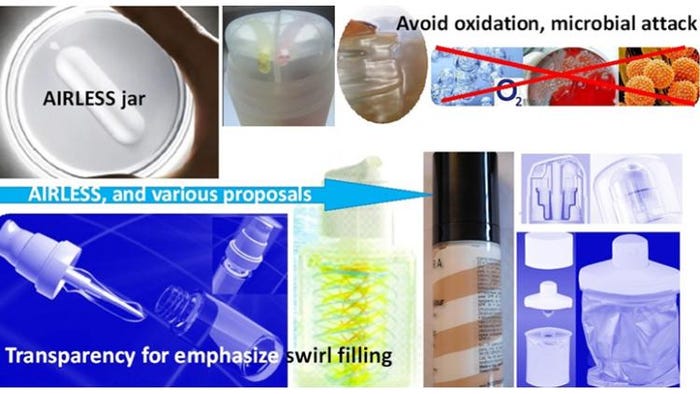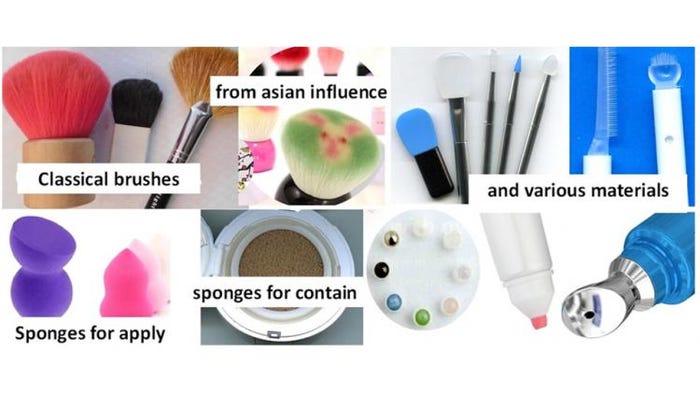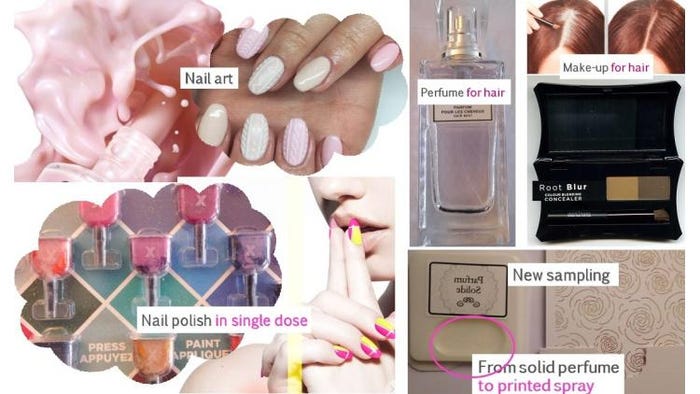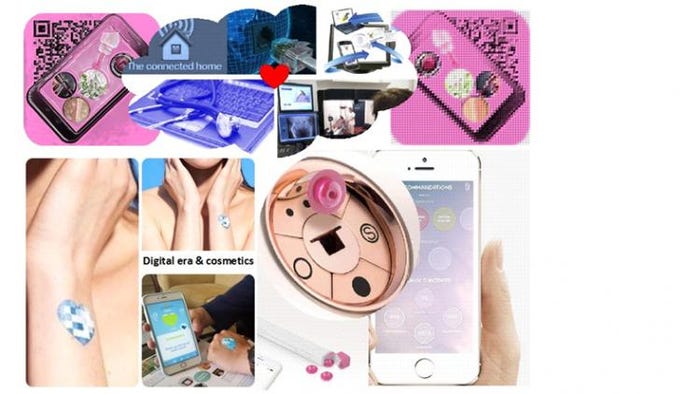
From new beauty tools like application sponges to a digital era that powers personalization and customization, the cosmetics market is leveraging innovation in packaging to delight consumers.
The cosmetics universe is always looking for innovative products. From all over the world, new trends and new packaging materials are providing ideas for new products [1-see references below].
Global cosmetics trends differ a bit by country: In the U.S., for example, the emphasis is on perfect skin, as labeled by Hollywood stars; Italians wonder about green and sustainable cosmetics; Germans are pragmatic and seek natural beauty and practice; in the UK, the main importance is on following the dictates of social networks (appearance reigns supreme); and the Japanese mix high-tech, efficiency and tradition.
One major global trend in cosmetics is the burgeoning market for men [2]. In prestige and mass combined, men’s global skincare sales grew 6.9% to $3.5 billion, a mere fraction of the total global men’s grooming market of $34.4 billion, according to Euromonitor. A lot of innovations in the men’s category are coming from Asia, as that remains the trendsetter for skincare. Despite a slowdown in the Western market for prestige men’s skincare, the market grew by double digits in Asia last year. For the men’s market, brands have a high level of expectation to emphasize control, performance and mastery.
At first, as the main purpose, packaging must contain the product, and separate and prevent it from touching or being exposed to the environment. As a second purpose, packaging must protect the product and prevent any physical damage. And now, packaging also must consider branding, distribution control and anti-counterfeiting [3, 4].
Packaging has a huge impact on all products (82%) and particularly for cosmetics (92%), according to a study from the observatory of packaging presented at WordPack 2014. Looking to the levers of innovation for the next two years, three have been identified: Sustainability, 59%; Ergonomics, 52%; and Protection and Transportation, 41%.
Plus Materials (48%) and Wording (20%) are particularly important for cosmetics packaging.
1. Combining form and function
For a long time, design has been associated with the look and the form. But in the mid-2000s, it appears associated with the function, so it adds value to the product.
Design encompasses ease of use and product performance—and it is essential for cosmetics. Some specific systems are much more than packaging, because they can change the product formulation [5]. For example, with a spray or foam, the physical form of a product can be modified. With a spray, the main ideas are to disperse the droplets, to create jet, to scatter the particles. With foam, there is production of small bubbles of gas, the gas is suspended in a liquid, there is effervescence, it can fizz or form bubbles [6].
Definitely, an aerosol is much more than just a package, because it is a pack that contains, protects, delivers a dose and is allowed to modify product textures. Sometimes it offers new sensations associated with visual and audible interactions.
With an aerosol package, a liquid-like substance can vary from the food area (liquid in bottle) to the care product area (water in spray) [6]. An aerosol spray uses gas or a mechanical pump process and can improve the product application on a larger surface easily (say, for perfume or sunscreen). The spray can modify the texture of product because gel, cream or foam can be created with this packaging system. Many new high-tech pumps empower the user to transform liquid formulas in a single press to produce a greater volume of luxurious foam that spreads easily onto the skin (foam color) (see Figure 1: Spray and foam examples).

Figure 1: Spray and foam examples.
Another clever package—the airless system—provides real safety to the formulation. An airless system is define as a tamper-proof unpressurized delivery system that associates a manual (mechanical) actuation pump with a container that, after filling and closing under vacuum conditions, delivers the product without air return.
The container, deformable or rigid, may be fitted with a piston or pouch, according to thedefinition proposed by Airless Pack Assn. (APA). An airless distribution system delivers and protects the product from all contaminations, such as oxidation, microbial attacks and pollution by allergens [7, 8]. Airless offers many benefits: a high product restitution, smoothness of pump and ease of use: in one push it’s done, with a possible distribution of 360-degrees, a precise and constant dosing, for a range of formulas, including viscous and unstable ones [9].
Airless systems have always been popular for the cosmetic market. Historically, the first airless systems appeared for toothpaste and were developed some years later for cosmetics. At first, airless packages were used for high-value products (to protect active cosmetic ingredients from oxidation). In 1996, airless packs using a pouch arrived and became more affordable. Now, airless packages are used for mass-market products. The technology also meets a real need for protecting natural and organic products.
A lot of new ideas are arriving, because airless allows new formulations that avoid preservatives. Definitely, airless systems have the wind in their sails with a market growth rate of 10% per year and 700 million units for cosmetics and pharmaceuticals. Main airless systems are: piston (85%); airless tube (8%); airless bag (6%); and airless jar (1%) [9].
Airless packaging [10] can use two to five times fewer preservatives—or totally avoid preservatives—from formulas. Airless allowed imagining and producing a new range of “sterile dermo-cosmetics.” There is sterilization throughout production, and the containment system guarantees the product remains sterile during its whole use.
The airless market is an aggressive sector with many innovations, such as new push-buttons that close as soon as the dose is delivered; new pumps; and clear containers that showcase the formulations (see Figure 2: Examples of innovation in the airless market) [7,10].

Figure 2: Examples of innovations in the airless market.
Sometimes the formula doesn’t require such a high degree of protection but brand marketers still choose an airless package because it’s an attractive container with a functional applicator. It is also easy, safe and quick in use.
2. Helpful tools
First there was an evolution in brushes. Now there is a real partnership of tools. Various new cosmetic products are specifically made to camouflage, contour and sculpt. Brands create brushes that meet a make-up product’s functionality and can be flexible in any position, or in various shapes that combine ergonomics and design. Rotating brushes are available and enable everyone to blend like a professional [11, 12, 13].
New tool materials are also helpful, like silicone used in various shapes and surfaces (smooths or textured). New “all-in-one” products allow deposition and application, like the patented microbristle applicator system (MBA) from Geka.
In the world of sponges, products can bedesigned for better functionality. Sponges apply product but also contain make-up. This is the new world of cushion, a tendency (once again coming from Asia) that comprises a spongy formula applied to the face with a pillow, which provides easy and flawless coverage [15]. Products now have multiple functions, with an added bonus of integrated sun protection (SPF), wrinkle prevention and antibacterial properties (see Figure 3: Tools with various shapes and materials).

Figure 3: Tools with various shapes and materials [1, 13, 14, 15].
Packages that contain and apply are another great tendency for cosmetics and, in the world of tube and applicators, a great diversity can be found with integrated pumps that allow adjustable side actuation and continuous formula dispensing.
3. Crossover ideas
Packaging from different fields (food, pharmacy) could deliver innovative systems for use with cosmetics. The idea of caviar for cream seems suitable with pearl delivery systems that keep various formulas separate to protect fragile active ingredients. However, packaging can move from the food market to cosmetics with sometimes dangerous ideas. Shampoos that look like a fruit juice pack or cleansers that mirror whipped cream containers can cause confusion, which can lead to problems for children.
Healthcare packaging is always in fashion. Pharmaceutical blisters and droppers can add a lot to cosmetics. Definitely, droppers give cosmetics a lot of new functionality. For example, airless droppers deliver a safe and precise dose of products, and twin-and-mix droppers help consumers reconstitute a formulation just before its use. We’re now seeing simple patches for cosmetics and make-up for nails and eye-liner (see Figure 4: Interconnections from pharmaceuticals to cosmetics) [1, 16].

Figure 4: Interconnections from pharmaceuticals to cosmetics.
Many interconnections from other markets provide interesting ideas for cosmetics—like pencils coming from schools and offices that are currently used for make-up or nail art.
4. New movements
Cosmetics marketers are thinking differently these days about their products and their uses. One great evolution in the nail area is not only new colors, but also textures of nail polish. “Nail art” has developed as a true fashion statement and presents beneficial seasonal opportunities for suppliers to create innovative products in this area.
Regarding hair care products: foam, creams and gel improve hair care. But how about hair perfume? Or specific make-up for hair, such as a new root concealer packaged as an eye shadow? Definitely, on that target, new proposals are arriving with interconnections from make-up. (See Figure 5: “Nail art” examples.)

Figure 5: From nail art to make-up for hair or new sampling packs.
New materials can add various functionality to the packaging, allowing consumers to heat the product just before use, or acknowledging the consumers’ nomadism (such as lipstick that opens with one hand, or an on-the-go package that blends formulations and lets consumers use them where and as they want) [17, 18, 19].
For sampling, cosmetics companies have created clever systems for perfume and make-up. Printed spray samples are used for olfactory marketing, connecting to ideas in a scientific study from the Rockefeller center that revealed human beings can remember 35% of what they feel (only 5% of what they see and 2% of what they hear). This neuro-sensorial marketing approach uses a camera in real time to see the impact of brands on the consumer’s face. And the tests are not in a lab, but in real shops. The neuro-marketing approach uses physiological measures, and analyzes target audience (conscious/unconscious) levels (such as a sensor that can measure on a smartphone the parameters of wellbeing on a woman who breathed a perfume).
5. Impact of the digital era [1, 20, 21]
We are living in a digital era and, for at least 10 years, people have widely integrated the internet into their daily lives. This huge development of a simplified digital world (affordable prices, simplified access) helps people consider computers as a part of their universe, which can facilitate exchange (between generations, scattered families)and the knowledge in all fields.
It is not a short fad but definitely a mutation. Going digital in all fields (including beauty and cosmetics) leads to a real change in consumer behavior: with ecommerce (40% growth estimated regarding sales figures for L’Oreal first half 2015);blogs or “vlogs” (video blogs)that stimulate sales; and “click and reserve,” a hybrid trade between physical sales and web which is developed by brands.
There is also the use of digital tools that modified—as a revolution—the relationships between brands and consumers. Various personalized skincare devices let consumers take control of their skin. Smartphone and tablet applications with similar principles: Take a photo and add different colors for hair or various face make-up (such as lip gloss or foundation)—and virtually test different make-up [22]. Digital packaging enables people to create their own customized package on line by choosing color, for example, or a message or video.
Digital can also help consumers diagnose their skin with new measuring devices, like a cosmetic shape memory mask with sensor that can identify the level of face hydration. After analysis, the mask triggers a boost effect on demand, enhancing the effect of formulation applied under the mask.
Following the era of electronic tattoos (that is, non-invasive and flexible medical patches for monitoring health [23]), L’Oreal introduced at CES 2016 the connected “MY UV Patch,” a flexible 2.5 cm2 patch, no thicker than a simple electronic circuit, with photosensitive elements that react to exposure to UV radiation. The color of the patch changes depending on the exposure time. The purpose is to protect consumers by educating them on best practices regarding exposure to the sun [24].
Another system is a “Nespresso-like cosmetic machine” that ingests small capsules with different functions (such as for hydration or anti-ageing) and mixes them into a bespoke serum. This allows consumers to personalize their care depending on age and skin specificities [25]. For manufacturing make-up, 3D printing can be seen as a new way for producing either cosmetic make-up or packaging, so there is a lot of opportunities in the near future with digital offers [26] (see Figure 6: Digital era and cosmetic products, some examples).

Figure 6: Digital era and cosmetic products, some examples. [1, 23, 25]
Conclusion
The cosmetic industry is a real innovative factory always in flux for offering dreams and pleasures to its user, and helping to create an ideal world of beauty. Efficiency should not be forgotten and all the new active products and ingredients, as well as new materials and forms, are perfectly represented in the cosmetic sector.
Preserving and improving this beauty capital that is so important in our image-centric world is a huge challenge that seems to be brilliantly successful partly because of innovative packaging.
References
1 – Gauthier, P., “Beauty enhancement, which advance and packaging challenges for which trends.” Beauty and make-up enhancement, the packaging innovation hub, 12thEdition Packaging of Perfume, Cosmetics and Design, ADF-PCD Oriex, Paris, Feb. 3, 2016.
2 – “Men’s market is changing his marks,” Expression Cosmétique, 205 N°34, 28-40.
3 – Bauer, E.J. “Pharmaceutical Packaging Handbook.” Ed Informa 2009, 585 p.
4 – Gauthier, P. “Much more than packs! Overview of innovative packaging that changes life of drugs forms.”Pharmapack Europe 2015, Paris, UBM Canon, Paris, 11-12th February 2015.
5 – Gauthier, P. “Formulation and packaging design for new chemical entities: Examining specific population and product repositioning,” Therapeutic Delivery, 2011, 2(7), 845-848.
6 – Gauthier, P. “Spray and foam, overview of products and use,” 7th Aerosol and Dispensing Forum, ADF-PCD Oriex, Paris, Feb. 6-8, 2013. “Spray and foam, overview of products and use.” Aerosol Europe, 2013, vol 21, N°6, 12-17.
7 – Gauthier, P. “Airless, when less is more, overview of products.” 12th Packaging Perfume Cosmetics and Design PCD, ADF-PCD Oriex, Paris, Feb. 3, 2016. “Airless, when less can be more.” Aerosol Europe, 2014, 22, 5, 23-27.
8 – Hellbardt, S. and Degenhard, M., “Trends in skin medication dispensing.” Drug Development and Delivery, 2013, vol 13, Sept., 40-45.
9 – “Airless vers des niveaux de qualité plus élevé.” Doses, 2015, N°59, 62-71.
10 – Airless links: http://www.yonwookorea.com/m/page/product_list.asp?s_local=AS; http://www.lablabo.com/lablaweb/index.php; http://www.lumson.it/en/airless-system/tag-system
11 – http://www.beautypackaging.com/issues/2015-06-01/view_features/applicators-evolve
12 – http://www.premiumbeautynews.com/en/six-key-packaging-trends-set-to,9091
13 – http://www.doll10.com/collections/brushes-and-tools/products/blendsmart-blush-brush-no-11
14 – https://www.linhardt.com/en/products/application-pens/medicpen-2/
15 – http://www.neopac.com/fr/innovations-neopac/innovations.html
16 – http://news.aptar.com/solutions/aptar-pharma-leverages-serumony-airless-dispensing-technology-from-aptar-beauty-home/
17 – http://www.webpackaging.com/en/portals/cosmogen/assets/11033994/cosmogens-new-self-heating-tube/
18 – http://www.variblend.com/
19 – http://www.premiumbeautynews.com/en/axilone-a-one-hand-lipstick,8433
20 – Gauthier, P. “Gaming: How can it advance drug delivery, digital health and a better world?” Drug Delivery Congress Europe, DDP, Berlin, Sept. 16-17, 2015.
21 – “les tendances du marché cosmétique,” 2015, Innovation Review, 88, 30-32.
22 – http://www.loreal-paris.fr/makeup-genius.aspx
23 – http://www.digitaltrends.com/wearables/loreal-my-uv-patch-hands-on/
24 – http://www.mintel.com/blog/personal-care-market-news/innovative-smart-bandage-aims-to-heal-first-aid-market
25 – http://wwd.com/beauty-industry-news/skin-care/romy-paris-a-next-generation-beauty-concept-10238267/
26 – http://www.orleans-cosmetics.com/#!actualits/c1dl4

Author Dr. Pascale Gauthier is a pharmacist with a Ph.D.and is in charge of marketing and design courses at Auvergne University, serving on the Biopharmacy & Pharmaceutical Technology Departmentfaculty of Pharmacy Clermont-Ferrand in France. Reach her by email at [email protected].
About the Author(s)
You May Also Like


